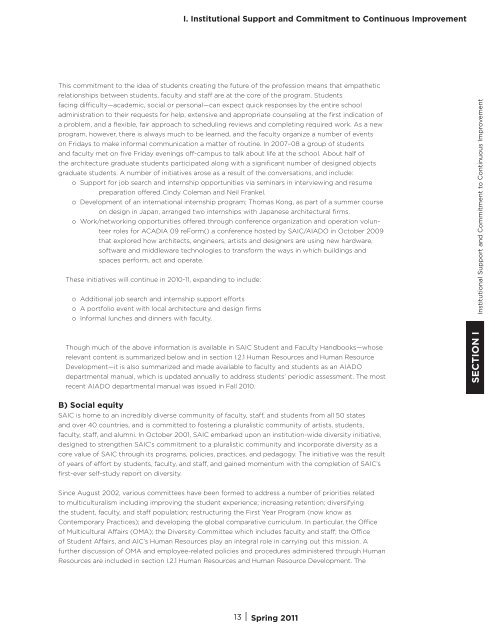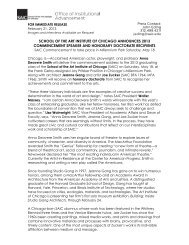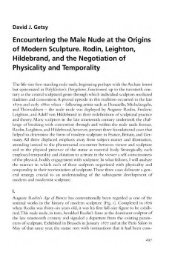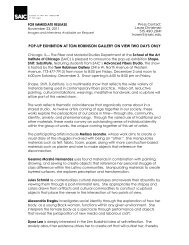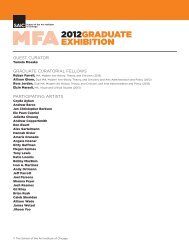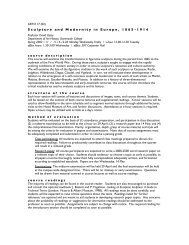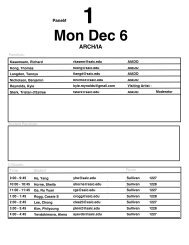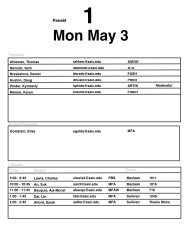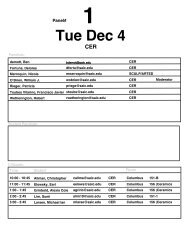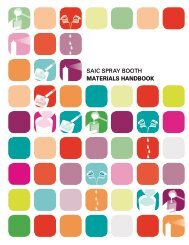i. institutional support and commitment to continuous improvement
i. institutional support and commitment to continuous improvement
i. institutional support and commitment to continuous improvement
You also want an ePaper? Increase the reach of your titles
YUMPU automatically turns print PDFs into web optimized ePapers that Google loves.
I. Institutional Support <strong>and</strong> Commitment <strong>to</strong> Continuous Improvement<br />
This <strong>commitment</strong> <strong>to</strong> the idea of students creating the future of the profession means that empathetic<br />
relationships between students, faculty <strong>and</strong> staff are at the core of the program. Students<br />
facing difficulty—academic, social or personal—can expect quick responses by the entire school<br />
administration <strong>to</strong> their requests for help, extensive <strong>and</strong> appropriate counseling at the first indication of<br />
a problem, <strong>and</strong> a flexible, fair approach <strong>to</strong> scheduling reviews <strong>and</strong> completing required work. As a new<br />
program, however, there is always much <strong>to</strong> be learned, <strong>and</strong> the faculty organize a number of events<br />
on Fridays <strong>to</strong> make informal communication a matter of routine. In 2007–08 a group of students<br />
<strong>and</strong> faculty met on five Friday evenings off-campus <strong>to</strong> talk about life at the school. About half of<br />
the architecture graduate students participated along with a significant number of designed objects<br />
graduate students. A number of initiatives arose as a result of the conversations, <strong>and</strong> include:<br />
o Support for job search <strong>and</strong> internship opportunities via seminars in interviewing <strong>and</strong> resume<br />
preparation offered Cindy Coleman <strong>and</strong> Neil Frankel.<br />
o Development of an international internship program; Thomas Kong, as part of a summer course<br />
on design in Japan, arranged two internships with Japanese architectural firms.<br />
o Work/networking opportunities offered through conference organization <strong>and</strong> operation volun-<br />
teer roles for ACADIA 09 reForm() a conference hosted by SAIC/AIADO in Oc<strong>to</strong>ber 2009<br />
that explored how architects, engineers, artists <strong>and</strong> designers are using new hardware,<br />
software <strong>and</strong> middleware technologies <strong>to</strong> transform the ways in which buildings <strong>and</strong><br />
spaces perform, act <strong>and</strong> operate.<br />
These initiatives will continue in 2010-11, exp<strong>and</strong>ing <strong>to</strong> include:<br />
o Additional job search <strong>and</strong> internship <strong>support</strong> efforts<br />
o A portfolio event with local architecture <strong>and</strong> design firms<br />
o Informal lunches <strong>and</strong> dinners with faculty.<br />
Though much of the above information is available in SAIC Student <strong>and</strong> Faculty H<strong>and</strong>books—whose<br />
relevant content is summarized below <strong>and</strong> in section I.2.1 Human Resources <strong>and</strong> Human Resource<br />
Development—it is also summarized <strong>and</strong> made available <strong>to</strong> faculty <strong>and</strong> students as an AIADO<br />
departmental manual, which is updated annually <strong>to</strong> address students’ periodic assessment. The most<br />
recent AIADO departmental manual was issued in Fall 2010.<br />
B) Social equity<br />
SAIC is home <strong>to</strong> an incredibly diverse community of faculty, staff, <strong>and</strong> students from all 50 states<br />
<strong>and</strong> over 40 countries, <strong>and</strong> is committed <strong>to</strong> fostering a pluralistic community of artists, students,<br />
faculty, staff, <strong>and</strong> alumni. In Oc<strong>to</strong>ber 2001, SAIC embarked upon an institution-wide diversity initiative,<br />
designed <strong>to</strong> strengthen SAIC’s <strong>commitment</strong> <strong>to</strong> a pluralistic community <strong>and</strong> incorporate diversity as a<br />
core value of SAIC through its programs, policies, practices, <strong>and</strong> pedagogy. The initiative was the result<br />
of years of effort by students, faculty, <strong>and</strong> staff, <strong>and</strong> gained momentum with the completion of SAIC’s<br />
first-ever self-study report on diversity.<br />
Since August 2002, various committees have been formed <strong>to</strong> address a number of priorities related<br />
<strong>to</strong> multiculturalism including improving the student experience; increasing retention; diversifying<br />
the student, faculty, <strong>and</strong> staff population; restructuring the First Year Program (now know as<br />
Contemporary Practices); <strong>and</strong> developing the global comparative curriculum. In particular, the Office<br />
of Multicultural Affairs (OMA); the Diversity Committee which includes faculty <strong>and</strong> staff; the Office<br />
of Student Affairs, <strong>and</strong> AIC’s Human Resources play an integral role in carrying out this mission. A<br />
further discussion of OMA <strong>and</strong> employee-related policies <strong>and</strong> procedures administered through Human<br />
Resources are included in section I.2.1 Human Resources <strong>and</strong> Human Resource Development. The<br />
13 | Spring 2011<br />
SECTION I Institutional Support <strong>and</strong> Commitment <strong>to</strong> Continuous Improvement


